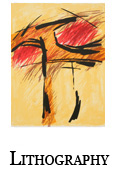
Emanuel Ranný’s poetic view of the world draws him close to the poets, to those best able to tell of things difficult to impart, of a similar way of perceiving the world in which there occurs the miraculous „inconclusiveness“ of word and picture, captured in the delicate web of poetic simile. Emanuel Ranný entered the world of art at the beginning of the eighties, when his vision matured of an abstract landscape, rather suggested in the black and white cadences of engraved lines, with light playing a decisive part. With the illustrations for Poe’s Raven this poem entered his work as a second significant inspiration and literally and definitively merged with his imagery. In Czech printmaking Emanuel Ranný is the only artist who has imprinted the dimension of monumentality into the intimate technique of dry point without diminishing its primary delicacy and lyrical expressivity. In the crystalline form of black and white contrasts he took advantage of the unrepeatable and sovereign decisiveness of the graphic form. The optically clearly legible structure of the prints is based on the dynamic hatching of curtly drawn lines copying the slight curve of the handdrawn line. Sometimes the horizontal articulation of the landscape is indicated; elsewhere points graduate vertically or twine around lighted peepholes. In the prints entitled Ukřižování (Crucifixion), Rosa Coeli and Modlitba (Prayer) the drawing takes on the natures of a stigmatic imprint, in others time is organised into parallel rain and like a field charged with energy it opens out into the surrounding space. Through the austerity of the light and the dramatic handling of matter Ranný´s prints are situated in wider local connotations, in deep-rooted medieval and baroque traditions with specific spiritual transcendentalism. The fact that some prints recall the open organism of a Gothic cathedral, rising up from the dark base of the earth into God’s sphere of the cosmos, is an accompanying association of the artist’s spiritually exposed sensibility. The sacred aspect is not, however, the intention, but the consequence of the universal view of nature and the world, awareness of the continuous oscillation of matter, light and energy in which the spiritual principle of being is clarified. The approach to landscape as a metaphysical likeness brings his landscapes close to Mácha’s luminism and at the same time he is the continuator of the naturalistic graphism of the Surrealist poetry of Šíma or John. On the background of these he transforms the „Raven landscape“ into a personal manifesto of faith as pledges for the nothingness of the world and returning faith.
Simeona Hošková, 5th International Triennial of Graphic Arts,
Old Town Hall, Prague 2007



